Find out why this ‘good idea’ isn’t.
Peanut butter with fish oil!
What will they think of next?!
Before writing this blog, I showed the new JIF Omega-3 Peanut Butter to a few people.
Most of the older people I showed it to said something like ‘Why don’t you just eat some Tuna or Salmon, for Pete’s sakes?’
And the kids said ‘Cool – what’s Omega-3?’
Us old folks forget how much we hated seafood when we were kids. Ugh! I used to run and open the windows when my mom cooked fish.
Getting Omega-3 into picky kids is not easy. If you can sneak some into peanut butter, great!
What’s not to like?
Here’s what you need to know about JIF Omega-3 Peanut Butter:
- It has 32 mg of Omega-3 per 2 Tablespoons
- The Omega-3 is from fish and not plants
- It has both EPA and DHA
Those are the facts.
32 mg of Omega-3. Is that enough? Is that a lot?
No and no.
32 mg is somewhere between sprinkling and fairy-dusting.
32 mg is not a random number. Some years ago, a few companies proposed to the FDA that if a food contained 32 mg of Omega-3 that it could be labeled as ‘High in Omega-3’ or ‘Good source of Omega-3.’
In 2007, the FDA reviewed these proposals and said ‘No way!’ The FDA said that the claim was ‘not based on an authoritative statement.’
In other words, not enough Omega-3.
So that’s where the 32 mg comes from. Food companies can add it their foods but just can’t make fancy claims about it like, it will ‘make your kids smarter.’
The Good News
The good news is that the Omega-3 contains DHA and EPA. These are the two critical Omega-3s that your body needs.
I’ve seen breads and tortillas with Omega-3 splashed across the packaging in giant letters. But when I looked closer, the Omega-3 was the ALA form made from Flaxseed oil.
ALA Omega-3 from Flaxseed is not readily absorbed. So that is a waste of money.
The other piece of good news is that JIF Omega-3 does not smell or taste fishy at all.
This is brilliant technology by the folks at Ocean Nutrition in Canada. They wrap or encapsulate teeny-tiny droplets of fish oil in gelatin. This keeps the odor and the healthy goodness contained on the inside.
The gelatin droplets mix nicely with the peanut butter.
I wish the gelatin-coated, powdered Omega-3 was available for purchase. You could add a teaspoon into your kids’ pancakes on Sunday morning. And they’d be none the wiser. Well, with enough DHA, they might actually get wiser!
Looking a Little Deeper…
Here is my concern:
Peanuts and peanut butter are too high in Omega-6.
The chart below shows that Peanuts have almost no Omega-3 and the fats are exclusively Omega-6.
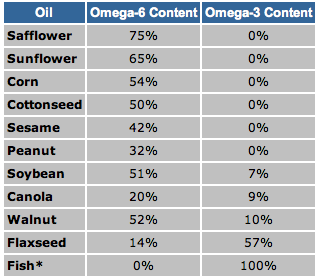
But excess Omega-6 aggravates a lot of health problems.*
Even though peanuts have a lot of other healthy nutrients, the high amount Omega-6 makes it an eat-only-occasionally snack.
Why? Because Omega-6 competes with Omega-3. Omega-6 fights with Omega-3 for enzymes in your body and fights with Omega-3 for placement into your body’s cells.
And Omega-3 loses this battle because we already have so much Omega-6 in our diet. The Omega-3 literally gets drowned out by Omega-6.
The more Omega-6 you eat, the higher your body’s need for Omega-3.
Nutritionally speaking, an Omega-3 enriched peanut butter is like a sleeping pill with added caffeine. It’s just, well, nutty.
Here’s the math to prove my point:
One serving is 2 tablespoons.
- Each serving of Omega-3 Peanut butter has 5 grams of polyunsaturated fat (Omega-6.)
- Each serving of Regular Peanut butter also has roughly 5 grams of Omega-6.
- Each serving of Reduced Fat Peanut Butter has about 3.75 grams of Omega-6. That 1.25 fewer grams of Omega-6 in the Reduced Fat Peanut Butter.
If you look at the JIF Omega-3 product, you have 40 times more Omega-6 than Omega-3. That’s a dangerous ratio!
The question that begs to be asked is:
Is eating 1250 mg less Omega-6 in the Reduced Fat Peanut Butter better than eating 32 mg more Omega-3 with the Omega-3 peanut butter?
The answer is easy: YES!!
You are MUCH better off eating JIF Reduced Fat Peanut Butter – it is by far the healthier option.
Surprised, aren’t you?
I was too.
If you want healthy kids, get them off sodas and fruit juice and don’t cook foods for them with seed oils rich in Omega-6 (corn and vegetable oils.)
Before you run out and buy the reduced fat peanut butter, know that:
- #2 ingredient is corn syrup – the stuff that makes Coca Cola so sweet.
- #3 ingredient is soy protein.
- #4 ingredient is a trans fat. Good Lord! I don’t want my twins anywhere near these ingredients.
Peanut butter should have one ingredient: peanuts. May be a hint of salt. That’s it. Like Laura Scudder Organic Peanut Butter.
May be ‘Choosy moms choose JIF,’ but informed moms should opt for Almond butter, which has a little less Omega-6.
Then again, may be the old-timers were right after all, you’re better off eating some Tuna or Sardines. For Pete’s sakes!
* These statements have not been evaluated by the Food and Drug Administration. This product is not intended to diagnose, treat, cure, or prevent any disease.
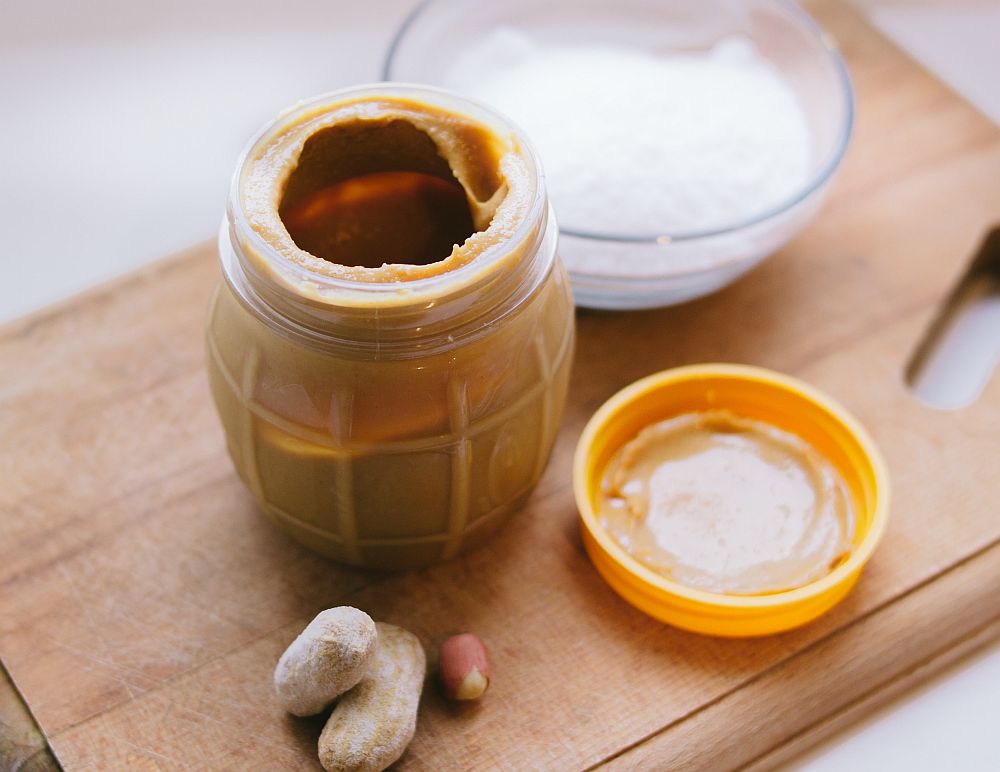
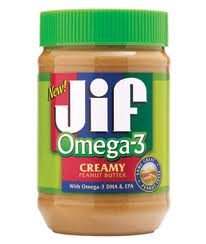
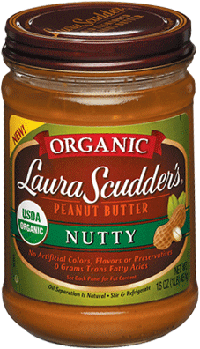
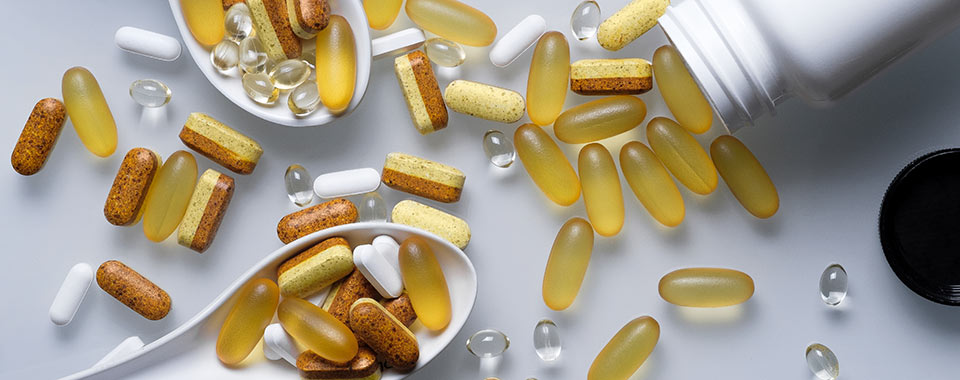

We’ll have to disagree on the Reduced Fat Jif being healthier. Despite having less Omega-6 fat, in my book, the product with trans fat automatically loses.
Dan,
Actually, Dan, I’m with you on this. My point in the blog was that Reduced Fat JIF was better for you than the Omega-3 JIF, but ONLY from an Omega-3 to Omega-6 ratio perspective. Peanut butter is full of Omega-6, so you’ll have to take an extra fish oil pill to make up for all the Omega-6 that comes from peanut butter. As for the trans fat in the Low Fat JIF, there’s plenty of it! And they can keep it. I won’t touch Low Fat JIF with the proverbial 10-foot pole. Peanut butter should have one ingredient: peanuts. If it has a little salt, well, I might be OK with that. But don’t give me anything more.
By the way, any food can have 500 mg of trans fat and still call their product ‘Trans-Fat-Free!’
There is such a thing as naturally occurring trans fat – Conjugated Linoleic Acid (CLA) in dairy is one example. It may not be bad for you like the artificial stuff. But barring that, there is NO PLACE for trans-fat in any normal human food.
Love the taste of it. Good for loaf bread or some chips/biscuits. The taste is same with the peanut butter we’ve have before. I think the more that gets appealing about this peanut butter is that there is Omega 3 Fish Oil.
I eat a lot of the Scudders PB because it has virtually no carbs. I guess I need to cut out the PB
from now on?
Of all the things you could eat, peanut butter is not the worst! Far from it. It’s just that almost all the oil (fat) in it is Omega-6. If you can cut out sugar, candy, soda, high-fructose corn syrup, fruit juice and then followed by wheat and wheat flour-based products, you will be better off than 95% of the American population. So my suggestion is to focus on eliminating sugar and wheat first. Then focus on cutting out other grains and vegetable oils. Focus on peanut butter after you’ve made the above changes.
You should have stopped at saying that peanuts and peanut butter are not good.
Reduced Fat Jif still has too high a ratio of Omega 6 to Omega 3.
Laura Scudder’s Organic Peanut Butter still has a 40:1 ratio even if it is organic.
Get away from the altar of organic.
Hi Louis, yeah, may be I should have stopped at ‘peanut butter is not good.’ I still think I made that point. But may be I diluted the message by offering a lesser-evil option at the end of the blog. I don’t care either way about Organic Laura Scudder item – but it was the only product I could find that had just one ingredient. I was trying to convey that IF YOU ABSOLUTELY MUST eat peanut butter, at least go for the ones with no added sugar and trans fats.
Vin, according to the USDA (food 16399) this omega-3 peanut butter has 821mg of Omega-3 and 1,076 of Omega-6 per a 1 oz serving. That’s nearly a 1:1 ratio. What gives?
Also, I was told to eat walnuts for a great source of Omega-3 (2.8 grams per oz) but they contain almost 11 grams of omega-6. Isn’t that much worst than peanut butter?
Confused.
Rob, I looked up USDA food 16399 and found several references for Creamy Omega-3 Peanut Butter but have not seen the 821 mg of Omega-3 you’re referring to. Can you share the direct link? Even without having seen or read the link, I am certain that NO peanut butter can have 821 mg of non-ALA-Omega-3 per serving because it would taste and smell like you bit into the head of a fish and it would be cost-prohibitive to market. Most ‘functional-foods’ have 100 mg of Omega-3 or less. Usually far less. Naturally, peanuts (a legume and not a real nut) have virtually zero Omega-3. The fats are almost all Omega-6. That’s why I don’t eat them. Walnuts are OK as long as you eat no more than a handful per day. Yes, they contain ALA Omega-3, which is not well absorbed but they also contain a lot of Omega-6, which you’re probably getting too much of. Most nuts have way too much Omega-6. See this for more info.
Would also like to add that Dr. Frank Sacks (Harvard) says balancing Omega-3 and Omega-6 is not necessary. See link:
http://www.hsph.harvard.edu/nutritionsource/questions/omega-3/index.html
Indeed he does. There is certainly plenty of evidence to support trans-fats being the worst and the fats in fish being the best. Omega-6 is necessary. In the eicosanoid pathway, Omega-6 CAN be converted to DGLA and then onto some very good (and powerful) eicosanoids. No doubt. You need Omega-6. Without it, we will die. However, Omega-6 can be channeled into Arachidonic Acid, a highly damaging eicosanoid in excess amounts, in the presence of insulin and absence of EPA Omega-3. High insulin and low EPA basically describes the standard condition most Americans. This is a very dangerous situation, a perfect storm if you will, that has nothing to with THEORY. We are consuming more sugar and Omega-6 now than at any time in human history. It is a grand experiment. Unless some pharma company can invent an enzyme inhibitor that can stop the conversion of DGLA to AA, we are driving with a tight blindfold. I don’t want to be a part of this experiment, so a few years ago, I stopped consuming sugar and have cut down drastically on Omega-6. Look into Dr. Lands work – he has spent a lifetime on this.
Vin
Thanks for the response!
Below is the link, I suspect it is an error.
http://skipthepie.org/legumes-and-legume-products/peanut-butter-with-omega-creamy/?weight=28
Oh wow! Rob, this is a treasure trove of interesting facts and dangerous half-truths. I will have to spend a lot more time look at the rest of this site. But clearly, they have assayed SOME peanut butter. The Omega-3 is probably ALA Omega-3, which is unusual to find in peanuts. I also find it a bit odd to find so much monounsaturated fats (about 10 out of 15 grams of fat) in peanut butter. Any nutrition site that lists saturated fats as “bad” and ALL polyunsaturated fats as “good” must be ignored in light of abundant evidence to the contrary. The site is recycling tired old nutritional dogma from the 1980s. Saturated fats are neutral at worst. And poly fats can be good or bad – depends on which one and what else is going on in your body. Very dangerous stuff, this…information! For what it’s worth, I wouldn’t be caught dead eating a white bread-n-peanut butter sandwich shown on the page! Wheat gluten, refined carbohydrates and Omega-6 fats! It’s almost as good as a donut when it comes to combining all the things I want to avoid!
I came upon a recipe for a treat for my two miniature Daschunds. It is peanut butter, bacon, one egg and oats. I roll the dough, cut them with a cookie cutter and bake them for 30 minutes. They are absolutely crazy for these treats and they don’t have preservatives. I have been using Skippy peanut butter, but thought I would switch to Jiff with omega3. Would there be any problems with the switch? They need the vitamins in the peanut butter so that sounds good for them. Your opinion?
Hi Judy – I think baking the Omega-3 may damage it a bit, but it is worth a try. You may be better off adding Omega-3 separately to their diet. Peanut butter is incredibly high in Omega-6 fats, which counteract the benefits of Omega-3 and it is not terribly high in vitamins. I like the bacon and eggs portion of the recipe. I’d skip the oats as it is not a natural part of the canine diet. The doggies like this stuff because it must be incredibly yummy. Guess they’re not that different from us after all.
I’d like to dispute the claim that ALA in flaxseed is not readily absorbed by the body. If the seed is whole, yes, it will pass straight through, however flaxseed meal & oil are both absorbed. This is something I learned from personal experience after some frantic research. At 40 I suddenly found myself with incessant dry skin and acne covering my cheeks. The beneath-the-skin boil kind. Never had it before. I’m thin, active & usually healthy (except for some knee & back trouble due to genetic causes + wear & tear).
I found this article http://www.ncbi.nlm.nih.gov/pmc/articles/PMC2836431/
& then read http://lpi.oregonstate.edu/infocenter/skin/EFA/
and a couple of other articles.
As a result I dosed myself with a tablespoon of flaxseed oil, morning and night, for a couple of months. By the end of the first week my skin began to clear. Within 3 weeks all scarring was gone. If I get complacent in my diet & start letting higher amounts of omega 6’s creep in I begin to see the same skin issues arising, and also experience more back pain. If I take krill oil as well and use flax meal in my diet as well as the oil my joint & back inflammation seems to subside better. ALA may not be turned into EPA & DHA in the body much, but I seriously think after observing my own body’s reaction that ALA is used more than originally thought – especially by our skin.
Hi Ellen – the connection between Omega-3 and skin has been well established but there may be skin-related benefits specific to ALA that we’ve not fully studied. It’s not that ALA is not readily absorbed – it is wonderfully absorbed. It simply isn’t converted easily to EPA and DHA. But for most people, going straight to the long chain fatty acids EPA and DHA will do the trick. In the meantime, getting some ALA through veggies, nuts and seeds is a good idea…just don’t depend on it to convert to DHA.
After reading the list of other ingredients in the butter I agree with you about the product – it almost seems hastily cobbled together by someone in marketing. A pity, as the idea of having omega 3 rich oils as the balancing base for an omega 6 & B3 rich peanut butter is enticing. I do miss peanut paste.
I STILL after reading all this remarks above cannot tell if the OMEGA 3 peanut butter JIF offers has GLUTEN in it ??????????
THX !!!
Hi Bev – I don’t think there was gluten in the product I tried, but it is easy to find out. Just call the toll free number on the bottle and the customer service rep will have the answer for you.
Very interesting. I didn’t know about the a fish oil Jif. But I started to investigate after regular Jif chunky started to smell like fish to me a year or two ago. I finally called Smuckers last week to complain. Now I wish I’d have known about the omega-3 variant. One wonders whether there is some cross contamination in the manufacturing process, and some of the gelatin fish microcapsules break in the process. I’m a lifelong Jif customer, for decades, but it just was a better product when Proctor & Gamble made it. I’m reluctantly switching.
Omega-3 PB is the best PB ever! and Target had none on its shelves this week! Sent me into hysterics —well, almost Certainly reduced reasons to go to Target.